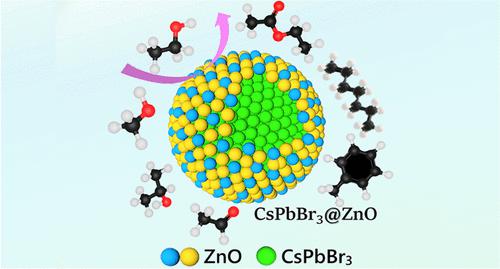Our official English website, www.x-mol.net, welcomes your
feedback! (Note: you will need to create a separate account there.)
Machine Learning-Assisted Sensor Based on CsPbBr3@ZnO Nanocrystals for Identifying Methanol in Mixed Environments
ACS Sensors ( IF 8.2 ) Pub Date : 2023-03-10 , DOI: 10.1021/acssensors.2c02656 Wufan Xuan 1, 2 , Lina Zheng 1, 2 , Lei Cao 1, 2 , Shujie Miao 1, 2 , Dunan Hu 3 , Lei Zhu 4 , Yulong Zhao 3 , Yinghuai Qiang 3 , Xiuquan Gu 3 , Sheng Huang 1, 2, 3
ACS Sensors ( IF 8.2 ) Pub Date : 2023-03-10 , DOI: 10.1021/acssensors.2c02656 Wufan Xuan 1, 2 , Lina Zheng 1, 2 , Lei Cao 1, 2 , Shujie Miao 1, 2 , Dunan Hu 3 , Lei Zhu 4 , Yulong Zhao 3 , Yinghuai Qiang 3 , Xiuquan Gu 3 , Sheng Huang 1, 2, 3
Affiliation

|
Methanol is a respiratory biomarker for pulmonary diseases, including COVID-19, and is a common chemical that may harm people if they are accidentally exposed to it. It is significant to effectively identify methanol in complex environments, yet few sensors can do so. In this work, the strategy of coating perovskites with metal oxides is proposed to synthesize core–shell CsPbBr3@ZnO nanocrystals. The CsPbBr3@ZnO sensor displays a response/recovery time of 3.27/3.11 s to 10 ppm methanol at room temperature, with a detection limit of 1 ppm. Using machine learning algorithms, the sensor can effectively identify methanol from an unknown gas mixture with 94% accuracy. Meanwhile, density functional theory is used to reveal the formation process of the core–shell structure and the target gas identification mechanism. The strong adsorption between CsPbBr3 and the ligand zinc acetylacetonate lays the foundation for the formation of the core–shell structure. The crystal structure, density of states, and band structure were influenced by different gases, which results in different response/recovery behaviors and makes it possible to identify methanol from mixed environments. Furthermore, due to the formation of type II band alignment, the gas response performance of the sensor is further improved under UV light irradiation.
中文翻译:

基于 CsPbBr3@ZnO 纳米晶体的机器学习辅助传感器用于识别混合环境中的甲醇
甲醇是包括 COVID-19 在内的肺部疾病的呼吸生物标志物,并且是一种常见的化学物质,如果不小心接触到它可能会对人造成伤害。在复杂环境中有效识别甲醇具有重要意义,但很少有传感器能做到。在这项工作中,提出了用金属氧化物包覆钙钛矿的策略来合成核-壳 CsPbBr 3 @ZnO 纳米晶体。CsPbBr 3@ZnO 传感器显示在室温下对 10 ppm 甲醇的响应/恢复时间为 3.27/3.11 秒,检测限为 1 ppm。使用机器学习算法,传感器可以有效地从未知气体混合物中识别出甲醇,准确率为 94%。同时,利用密度泛函理论揭示了核壳结构的形成过程和目标气体识别机理。CsPbBr 3之间的强吸附配体乙酰丙酮锌为核壳结构的形成奠定了基础。晶体结构、态密度和能带结构受不同气体的影响,从而导致不同的响应/恢复行为,并使得从混合环境中识别甲醇成为可能。此外,由于II型带排列的形成,传感器在紫外光照射下的气体响应性能进一步提高。
更新日期:2023-03-10
中文翻译:

基于 CsPbBr3@ZnO 纳米晶体的机器学习辅助传感器用于识别混合环境中的甲醇
甲醇是包括 COVID-19 在内的肺部疾病的呼吸生物标志物,并且是一种常见的化学物质,如果不小心接触到它可能会对人造成伤害。在复杂环境中有效识别甲醇具有重要意义,但很少有传感器能做到。在这项工作中,提出了用金属氧化物包覆钙钛矿的策略来合成核-壳 CsPbBr 3 @ZnO 纳米晶体。CsPbBr 3@ZnO 传感器显示在室温下对 10 ppm 甲醇的响应/恢复时间为 3.27/3.11 秒,检测限为 1 ppm。使用机器学习算法,传感器可以有效地从未知气体混合物中识别出甲醇,准确率为 94%。同时,利用密度泛函理论揭示了核壳结构的形成过程和目标气体识别机理。CsPbBr 3之间的强吸附配体乙酰丙酮锌为核壳结构的形成奠定了基础。晶体结构、态密度和能带结构受不同气体的影响,从而导致不同的响应/恢复行为,并使得从混合环境中识别甲醇成为可能。此外,由于II型带排列的形成,传感器在紫外光照射下的气体响应性能进一步提高。











































 京公网安备 11010802027423号
京公网安备 11010802027423号